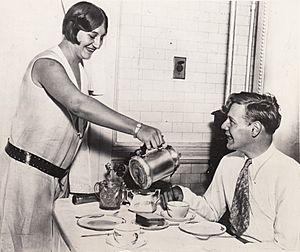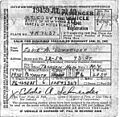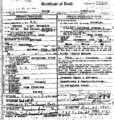Eddie August Schneider facts for kids
Quick facts for kids
Eddie August Schneider
|
|
|---|---|
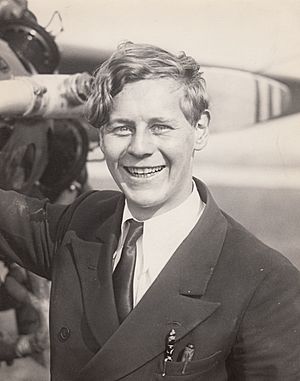
Schneider on September 10, 1930 in Detroit, Michigan for the National Air Races
|
|
| Personal details | |
| Born |
Eddie August Henry Schneider
October 20, 1911 Manhattan, New York, U.S. |
| Died | December 23, 1940 (aged 29) Brooklyn, New York, U.S. |
| Cause of death | Mid-air collision |
| Resting place | Fairview Cemetery |
| Spouse |
Gretchen Hahnen
(m. 1934) |
| Parents | Emil August Schneider (1886–1955) Inga Karoline Pedersen (1882–1927) |
| Education | William L. Dickinson High School |
| Occupation | Aviator |
| Known for |
|
| Signature | |
| Military career | |
| Allegiance | Spanish Republic |
| Service/ |
Yankee Squadron |
| Years of service | 1935–1936 |
| Rank | Aviator |
| Battles/wars | Spanish Civil War |
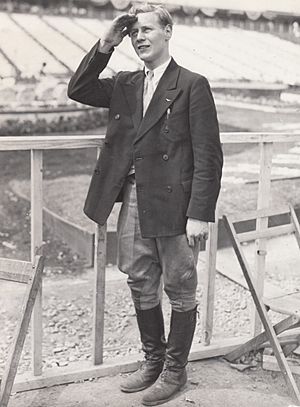
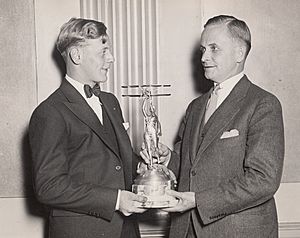
Eddie August Henry Schneider (born October 20, 1911 – died December 23, 1940) was an American aviator. He became famous for setting three transcontinental airspeed records in 1930. He was under 21 years old at the time.
Eddie flew a special plane called "The Kangaroo." It was a Cessna Model AW with a Warner-Scarab engine. He set records for flying from east to west, west to east, and for the full round trip across the United States. He was also the youngest certified pilot and airplane mechanic in the U.S. Later, he flew in the Spanish Civil War as part of the Yankee Squadron. Sadly, Eddie died in an airplane crash in 1940 while teaching another pilot.
Contents
Early Life and Flying Dreams
Eddie August Henry Schneider was born in Manhattan, New York, on October 20, 1911. His father, Emil August Schneider, was from Germany, and his mother, Inga Karoline Eldora Pedersen, was from Norway. Eddie had one sister named Alice.
His family moved to Jersey City, New Jersey, where his father owned a deli. Eddie went to William L. Dickinson High School. However, he left school at age 15 in 1926 to work as an airplane mechanic. He worked at Roosevelt Field on Long Island.
After his mother passed away in 1927, Eddie visited relatives in Germany and Norway. During this trip, he took a plane ride from Hamburg to Hanover. This flight made him obsessed with aviation.
Becoming a Young Pilot
From 1928 to 1929, Eddie trained at Roosevelt Field. He became the youngest person in the United States to get a commercial pilot certificate. In the same year, he also became the youngest certified airplane mechanic in New York.
In April 1930, Eddie's father bought him a used, red, 1927 Cessna Model AW monoplane. This plane had already flown half a million miles! Eddie named it "the kangaroo," hoping it would help him make quick "jumps" across the country.
Setting Air Speed Records
On July 30, 1930, Eddie announced his plan to fly to the Pacific coast and back. On August 25, 1930, he achieved his goal. He set the round-trip transcontinental air speed record for pilots under 21 years old. His flight was supported by Richfield Oil.
He flew from Westfield, New Jersey, on August 14, 1930, to Los Angeles, California. This trip took him 4 days, with a total flying time of 29 hours and 55 minutes. He broke the East-to-West record by 4 hours and 22 minutes.
Then, he flew back from Los Angeles to Roosevelt Airfield in New York. The return trip took 27 hours and 19 minutes. This broke the West-to-East record by 1 hour and 36 minutes. His total time for the round trip was 57 hours and 14 minutes. He beat the previous record holder, Frank Herbert Goldsborough, by more than 5 hours. When he landed in New York, his first words to his father were, "Hello Pop, I made it." He set three records in total!
Air Tours and Trophies
After setting his transcontinental records, Eddie joined the 1930 Ford National Reliability Air Tour in Chicago. This event took place from August 23 to September 1, 1930. He won the Great Lakes Trophy during this tour.
In 1931, Eddie participated in the last Ford National Reliability Air Tour. While flying over Kentucky, his engine had a problem, and he had to land his Cessna in a cornfield on a mountain. A new engine was sent to him. After a difficult takeoff, he continued the tour. He won first place for single-engine aircraft and finished third overall in the competition.
Time magazine once wrote about a close call Eddie had during an air tour. He was taking off from Chicago when he saw a large transport plane directly above him. Passengers on the bigger plane quickly moved to one side to tilt its wing up. Eddie quickly dove his plane. The larger plane's wing scraped his plane's wing, but he avoided a crash. Officials said his quick action saved many people from a serious accident.
Marriage and Flying School
In 1932, Eddie started working for the Hoover Air League as a co-director of their Aviation Division. On June 2, 1934, he married Gretchen Frances Hahnen in New York City.
Gretchen was involved in aviation too. She was the director of the Aviation Club for The Jersey Journal newspaper. She also edited their Junior Club Magazine. Eddie and Gretchen met at an aviation event. They did not have any children.
Running Jersey City Airport
Starting in 1935, Eddie leased the Jersey City Airport. He ran his flying school there. One day, while taking off with a student, his plane's engine stopped at 100 feet. They crashed into Newark Bay but were not hurt and walked to shore. Eddie taught many students to fly, sometimes with very few lessons. The airport later became a sports stadium.
Flying in the Spanish Civil War
In 1936, Eddie went to Spain to fly for the Spanish Loyalists in the Spanish Civil War. He joined a group of American pilots called the Yankee Squadron. Other pilots included Frederic Ives Lord and Bertrand Blanchard Acosta. They were recruited by a lawyer in New York City.
Eddie was promised $1,500 each month and a bonus for every enemy plane he shot down. However, the planes they were given were old and not in good condition. The American pilots faced many difficulties. Eventually, Eddie and others decided to return to the United States.
When he returned to New York City in January 1937, Eddie said he was not paid in full. He and other pilots had to answer questions from U.S. officials about their involvement. Their passports were temporarily held.
Later Years and Tragic Death
In 1938, Eddie was 5 feet 8 inches tall and weighed 160 pounds. He had blue eyes and blond hair. He began working for American Airlines at Newark Airport in New Jersey. Later, he moved to Jackson Heights, Queens, when American Airlines moved its eastern terminal to LaGuardia Airport.
On December 23, 1940, Eddie was tragically killed in an accident at Floyd Bennett Field. He was 29 years old. He was training another pilot, George Wilson Herzog. They were flying at about 600 feet, getting ready to land. Another plane, a Boeing-Stearman Model 75 flown by Kenneth A. Kuehner, hit the tail of Eddie's plane. Eddie's plane spun and crashed into Deep Creek. An investigation found that the other pilot was at fault for flying too low and not seeing Eddie's plane.
Legacy
After Eddie's death, his wife, Gretchen, sought support from Congress for his funeral expenses. She later donated Eddie's books to the Smithsonian Institution, which are now at the National Air and Space Museum. In 1961, Gretchen received an award from the Early Fliers Club of Long Island, honoring Eddie's contributions to aviation.
Eddie's Famous Plane
- His 1927 Cessna Model AW was called "the Kangaroo." It was first painted red. By January 1931, it was painted in the blue and cream colors of the Richfield Oil Corporation. Eddie said, "We named the ship the Kangaroo, because we hoped I could get to California in a couple of jumps."
Major Air Races Eddie Participated In
- 1930 Ford National Reliability Air Tour (National Air Tour) in Detroit, Michigan. He flew plane number 21 and won the Great Lakes Trophy, finishing eighth overall.
- 1931 Ford National Reliability Air Tour (National Air Tour) in Detroit, Michigan. He flew plane number 17. He won first place for single-engine planes and finished third overall.
Junior Transcontinental Air Speed Record Holders
- 1930 Frank Herbert Goldsborough
- 1930 Eddie August Schneider
- 1930 Robert Nietzel Buck
Images for kids




